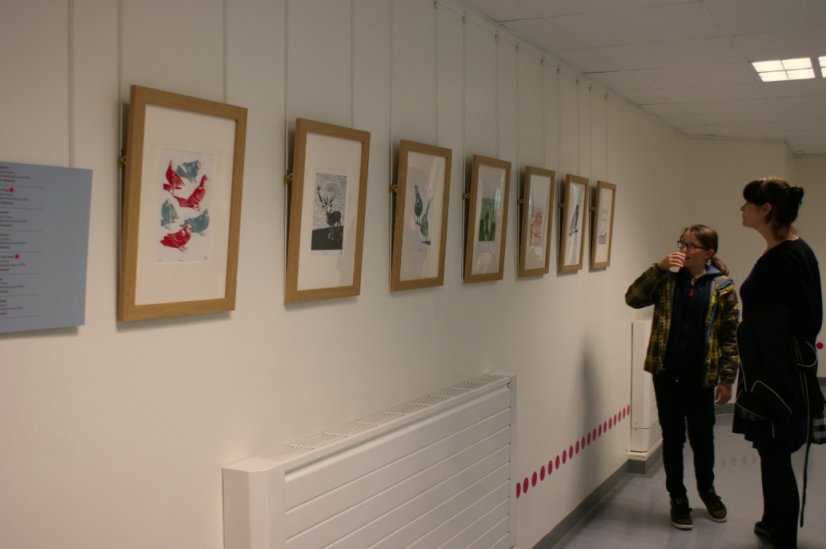
A patient and her mother view the paintings in the hospital's Long Gallery
Worth getting out of bed for
Transforming cold and clinical spaces in Sheffield’s children’s hospital into micro-museums and galleries is alleviating patients’ anxieties and helping them to heal faster. Cat Powell explains.
Between 1972 and 1981 patients in a suburban Pennsylvanian hospital were examined to see whether their proximity to a window with a view out to nature could have restorative properties. The study by Roger Ulrich was resounding in its demonstration that surroundings can impact on healing, with those with a view recovering a day faster and needing less pain relief. Since then, a growing body of research has proved that surroundings, specifically art, help heal patients. My organisation Artfelt, based at The Children’s Hospital Charity in Sheffield, is premised around the idea that making a space more visually interesting dramatically improves your experience of being there. Presentation of a space in hospital puts you in mind of how you will be treated in that space. We want to take a child’s mind off waiting, giving them something they can interact with and help them create talking points with their families.
We want to take a child’s mind off waiting, giving them something they can interact with and help them create talking points with their families
Engaging with the arts can make a difference to a stay on the wards, by transforming cold and clinical spaces into micro-museums and galleries. In one of our projects, we work with artists to bring art into a dedicated exhibition space called ‘The Long Gallery’. The exhibitions are sometimes work that we have done with our patients, with themes that are relevant to Sheffield, healthcare or childhood. The changing exhibitions keep the environment fresh and stimulating. It gives our patients and their families – some of whom would never usually access the arts – a place for respite and enjoyment. Our current exhibition, on loan from the National Fairground Archive, is a range of fairground posters from the last 200 years, as well as a selection of black and white photographs of the people who toured with the shows. I see patients every day stop and look at these pictures. To see them engage and appreciate the art is proof that the art is more than decorative – it is getting them out of their beds and getting them engaging with something other than their medical treatment.
As part of our work we also host workshops on the wards to help prepare children for surgery or to break up long days. Jackie Sanderson, Ward Manager of the Theatre Admissions unit, said: “The effect it has on the ward and the children is brilliant. From our point of view the workshops help to alleviate anxieties and stress from children prior to theatre.” Other successes over the last few years include:
- Working with the x-ray team to create fun and exciting artwork by producing scanned popular toys for their very own Toy Story;
- Designing emotion boards for the psychology department to help patients discuss their feelings;
- Working with the Victoria & Albert Museum and Museums Sheffield to bring toys from every decade of the hospital’s lifespan to the A&E department;
- Helping create a visually exciting space for the eye department.
I want spaces to reflect the care delivered on the wards. The hospital is a world-class centre, with specialisms ranging from neurosurgery, clinical genetics and gastroenterology, to major trauma and oncology. In a bid to bring our facilities in line with our expertise, we are in the middle of a £40m hospital redevelopment. As part of that and funded through our ‘Make it Better’ appeal, we are creating art within the fabric of a new wing. The first phase of art commissions will see artists working with glass and interactive lighting to create a visually stimulating space on the newly created public stairwell, visible from outside through large panel windows. Art and design to fill the large atrium, which will be the hub of the new wing, is set to include work with metals, glass, graphics and digital printing to create pieces to appeal to our patients.
The current arts strategy is based on working with an existing building and working on top of what is already there. With the new build, we have been there since the beginning, from the appointment of the architects, to overseeing plans to ensure that there are clear spaces provided for art in all its forms.
Cat Powell is Manager of Artfelt at The Children’s Hospital Charity in Sheffield.
www.tchc.org.uk/artfelt

Join the Discussion
You must be logged in to post a comment.